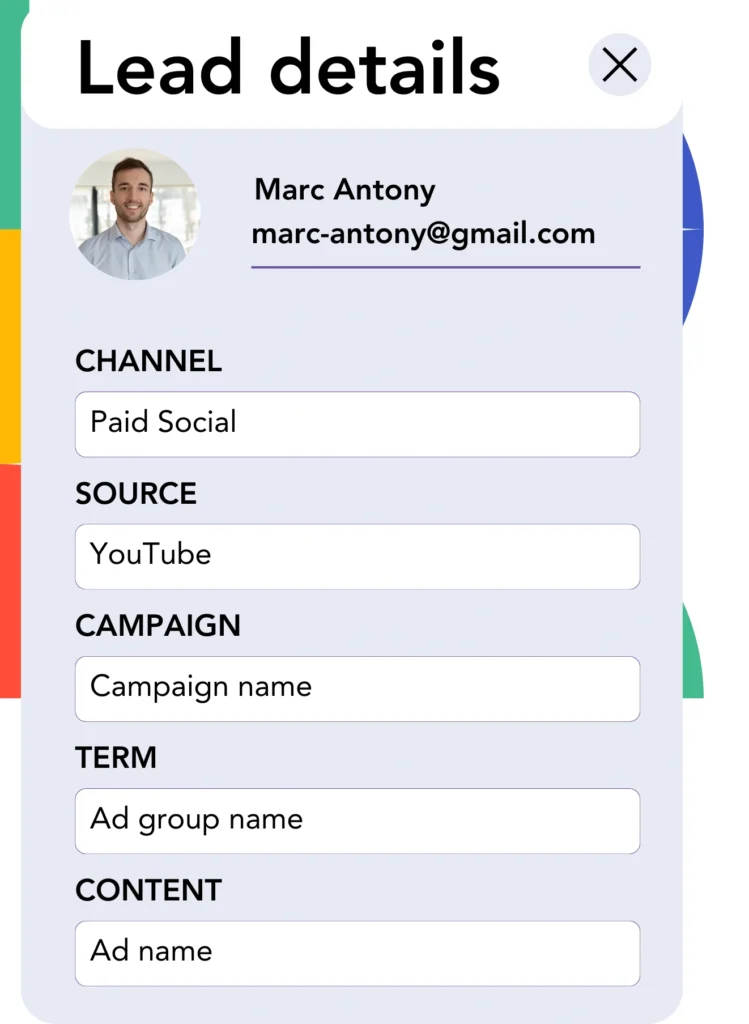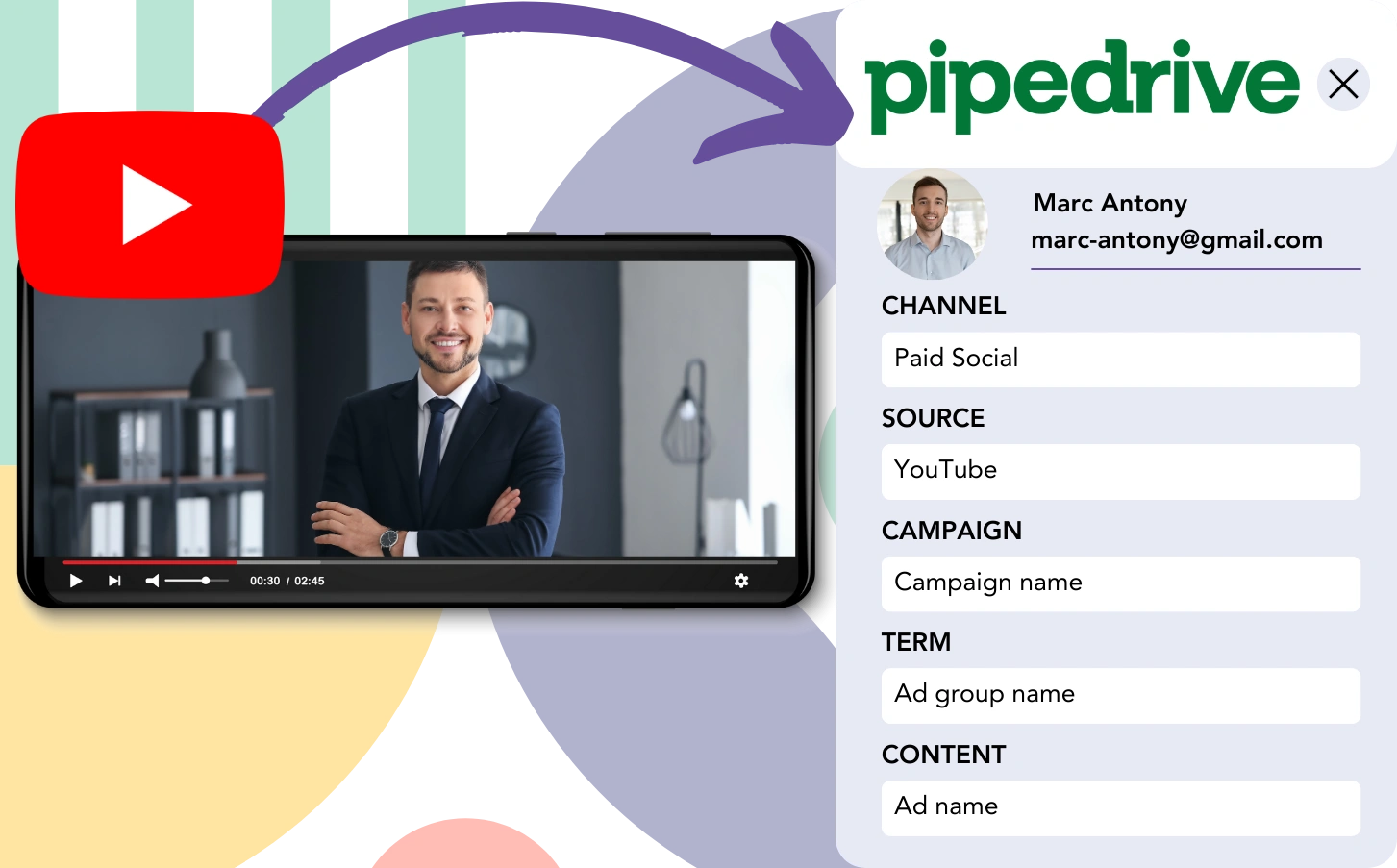Leads are generated on YouTube and directed to Pipedrive, yet each lead’s origin from a specific YouTube ad is untraceable. Consequently, after a lead becomes a customer, connecting that customer to the exact YouTube ad remains unfeasible.
Without tracking, you can’t measure your YouTube ads performance, so it’s hard to tell which ads truly bring in leads and customers. As a result, you allocate budget across numerous ads without knowing their actual impact.
Luckily, it’s simple to associate each lead with the specific YouTube campaign, ad group, and ad that brought it in.
We’ll go over each step together!
How to Track YouTube Ads in Pipedrive
Step 1: Add Leadsources in the head tag of your website

Leadsources offers a simple way to identify lead origins. When added to your site, it gathers up to 7 types of source information for every lead you capture.
➡️ Sign up to Leadsources.io for free
➡️ Add the Leadsources tracking code to your site
Step 2: Add the UTM parameters to your YouTube Ads

Add UTM parameters to your ad URL to capture details from YouTube ads, including campaign, ad group, and ad. Consider using these examples:
UTM_source=YouTubeUTM_campaign=campaign-nameUTM_term=ad-group-nameUTM_content=ad-name
The final URL will look like this:
https://www.yourdomain.com/?&UTM_source=youtube&UTM_campaign=campaign-name&UTM_term=ad-group-name&UTM_content=ad-namePlease note: Leadsources captures lead source information, even if UTM parameters are not included, for thorough lead tracking.
Step 3: Add the hidden fields in your form

Hidden fields in forms are not visible to users, yet they contain information that is sent with the form submission.
The lead source data is saved in these hidden fields by Leadsources. Upon form submission, Leadsources fills these fields with YouTube Ads information.
Step 4: Capture the YouTube Ads data in Pipedrive

Leadsources fetches the YouTube campaign, ad group, ad data, and more when users click your ads and visit your site.
Afterward, Leadsources fills the hidden fields of your form with this YouTube ad data.
After the form submission, the YouTube ad data and lead details will be visible in Pipedrive (ensure your form is connected to Pipedrive).
How does Leadsources work?
Every time a user lands on your site, Leadsources fetches YouTube ad data and populates it into the hidden fields of your form. Upon form submission, this data, together with lead information, is forwarded to Pipedrive.
With Leadsources, you can track the source data for each and every lead:
| Lead source data | Fetched automatically |
| Channel | ✅ |
| Source | ✅ |
| Campaign | ✅ OR use UTM_campaign |
| Content | UTM_content parameter is required |
| Term | UTM_term parameter is required |
| Landing page | ✅ |
| Landing page subfolder | ✅ |
As the table above shows, when UTM parameters cannot be used—such as for organic sources like Google search or when your website is featured in an article—Leadsources continues to track the following lead source data:
- Channel
- Source
- Campaign
- Landing page
- Landing page subfolder
Unlike other platforms, Leadsources keeps track of lead sources across every marketing channel, both organic and paid.
Performance reports: Lead, sales, and revenue by source
With YouTube Ads data tracked in Pipedrive, you can create reports that analyze performance, including:
- Leads, sales, and revenue by channel
- Leads, sales, and revenue by source
- Leads, sales, and revenue by campaign (aka. YouTube campaign)
- Leads, sales, and revenue by term (aka. YouTube ad group)
- Leads, sales, and revenue by content (aka. YouTube ad)
With this information, you can optimize your YouTube Ads budget based on the campaigns, ad groups, and ads that bring in the highest number of leads, sales, and revenue.
Here are a few examples of the reports you can generate!
1. Lead source reports
Create performance reports that highlight the number of leads generated by:
- Channel
- Source
- Campaign (aka. YouTube campaign)
- Term (aka. YouTube ad group)
- Content (aka. YouTube ad)
- Landing page
- Landing page subfolder
Example #1: Leads by channel
With this report, you can find out which channel generates the highest number of leads.

Example #2: Leads by YouTube campaign
Now, you can focus on a specific lead source (e.g., YouTube) and track how many leads each YouTube campaign generates.

Example #3: Leads by YouTube ad
After finding the YouTube campaign that generates the most leads, you can investigate which specific ad group or ad is driving those results.

2. Sales and revenue source reports
With the knowledge of which YouTube campaign, ad group, and ad are driving our leads, it’s time to assess whether these leads are turning into sales and revenue.
To make this happen, integrate your leads with a CRM like Pipedrive. By doing so, you can track the sales and revenue generated by various channels, sources, YouTube campaigns, ad groups, ads, landing pages, and their subfolders.
This data allows you to adjust your YouTube Ads strategy to focus on the channels, sources, campaigns, ad groups, and ads that generate the highest sales and revenue.
There are different types of reports you can generate to analyze sales and revenue, such as:
- Sales and revenue by channel
- Sales and revenue by source
- Sales and revenue by campaign
- Sales and revenue by term (e.g., YouTube ad group)
- Sales and revenue by content (e.g., YouTube ad)
- Sales and revenue by landing page
- Sales and revenue by landing page subfolder
Example Scenario:
| Channel | Search Paid | Social Paid |
|---|---|---|
| Leads | 50 | 75 |
| Sales | 5 | 6 |
| Average Order Value | $150 | $100 |
| Revenue | $750 | $600 |
After running ads on Google and YouTube, the initial “Leads by Channel” report revealed that YouTube’s Social Paid ads generated more leads than Google’s Search Paid ads.
Upon analyzing sales and revenue data in Pipedrive, you realized that the Search Paid channel was driving higher revenue, despite fewer leads, compared to the Social Paid channel. With this information, you adjusted your budget to prioritize the Search Paid channel.
LeadSources tracks the source of each lead in Pipedrive, whether they come from ads, organic search, social, email, etc. and syncs that data with each submission. See the full breakdown on the lead source in Pipedrive page.

